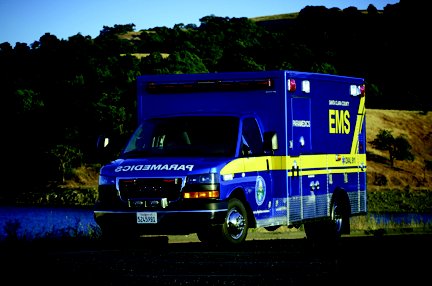Elena Miles says she would rather risk death than pay the exorbitant cost of riding in a Rural Metro Santa Clara County EMS ambulance, which is not considered in-network for any major insurance providers.
“I told my husband I’ll take the chance to die,” said the 54-year-old Gilroy native who suffers from Chronic Obstructive Pulmonary Disease. “It’s cheaper to die than it is to ride their ambulance.”
Gilroyan Johnnie Shackelford – who recently had to transport her son to Saint Louise Regional Hospital via ambulance – will also think twice about calling the ambulance again for any reason, thanks to what she calls “super aggressive” collection calls from Rural Metro.
“I told them, ‘You can just keep calling and harassing me. I’m not going to pay because he has coverage,’” said Shackelford, whose son is covered under MediCal and previously suffered a cut on his forehead. “They were very, very aggressive about getting money from me.”
Shackelford and Miles’ cases are not isolated.
The Dispatch has received several messages with personal stories from residents who feel they’ve been taken for a ride by Rural Metro with excessive ambulance transportation costs upwards of $2,000 per trip.
“My wife went for a 3-mile ride in the ambulance early last year, and along with the typical $35 for one baby aspirin, that ride cost us over $1,700,” wrote one resident. Jeff, a local businessman who asked for his last name not to be published, explained that his Blue Cross PPO provider covered $850 of the cost and “the rest we had to pay out of pocket” since Blue Cross does not have a contract with Rural Metro.
Rural Metro serves 14 of the county’s 15 incorporated cities (Palo Alto being the exception) and nearly 700 communities in 21 states. Santa Clara County Supervisors awarded Rural Metro the contract in 2011 to be the “exclusive provider of 911 and emergency ambulance service within Santa Clara County,” according to a press release from Director Michael Petrie with County Emergency Medical Services.
Previously, American Medical Response, which services more than 2,100 communities nationally, including 30 in California, had those exclusive rights for more than 30 years.
When the time came to review AMR’s contract, the county made a request for proposal and began a bidding process for the exclusive area rights, which is the case every decade. The Board of Supervisors then voted 3-2 in favor of Rural Metro because “the savings would be more than 12 percent for the five-year contract that is worth about $375 million.” City of Gilroy Mayor Don Gage, who was Santa Clara County Supervisor for District I at the time, voted in favor of Rural Metro.
Tom Wagner, Regional Chief Executive Officer for AMR, said the company had “exemplary performance the previous 10 years” and the county’s decision was solely “price-driven.”
However, Wagner claimed that Rural Metro’s bid was “below the costs to provide the service” and that AMR’s bid was higher because it was sustainable for the company.
“We are certainly very interested in the (Santa Clara County) contract and bidding it again,” he added.
In regards to the pile-up of complaints, Petrie said the county will “certainly follow up with Rural Metro” on residents’ concerns because they are “not consistent with what we’ve been told” by Rural Metro.
The county monitors and regulates the costs any 9-1-1 ambulance company imposes on a patient, but “we do not monitor insurance companies” for what is covered on their plans, Petrie explained.
The County’s decision to award Rural Metro with a five-year contract for exclusive operating rights in Santa Clara County was based on criteria of “clinical care, good operations effectiveness and patient satisfaction,” according to Petrie.
But some local patients are not satisfied.
Grace Pinot, of Morgan Hill, read personal accounts printed in the Gilroy Dispatch and Morgan Hill Times and decided to call the billing department to find out what types of insurances Rural Metro accepts as “in-network.”
Pinot had not used Rural Metro, but wanted to know just in case. She was horrified to learn there were none besides government providers: MediCal, Medicare and Medicaid.
“So I need to quit my job and go on welfare,” said Pinot, who was transported by an EMR ambulance in the past and had no issues getting the cost fully covered by her insurance. “They billed my Blue Cross and that’s all there was to it.”
Division General Manager Mark Norman for Rural Metro Santa Clara County 9-1-1 said it is “not unusual” for ambulance companies to not have contracts with insurance providers for emergency services. He does not know of any in-the-works or possible future negotiations between Rural Metro and non-government major providers.
However, according to Norman, Rural Metro did negotiate terms with Valley Health Plan, a 4,500-member insurance option for County of Santa Clara employees, and submitted it for review by the county. They are still waiting for county approval to accept Valley Health Plan.
“It’s a frustrating thing for citizens and I understand that,” said Norman, who advises upset customers to visit Rural Metro’s local office at 1345 Vander Way in San Jose, call the billing line at (408) 645-7330 or go online at www.santaclaracountyemsambulance.com. “We pride ourselves in keeping our costs low to the general public.”
But members of the public, especially those with chronic medical conditions, say Rural Metro puts them between a rock and a hard place.
“They are putting everyone, not just myself, in a bad position,” explained Miles, who could not afford to pay off the remaining balance of her near $2,000 tab after her Anthem Blue Cross provider paid just $246. “I couldn’t talk (when the EMTs arrived), so I couldn’t ask, ‘Are you in my network?’”
A part-time insurance broker herself, Miles decided to fight the remainder of the bill from Rural Metro, which she agreed to pay $50 a month after Rural threatened to turn the issue over to collections. She was already paying $856 a month plus the first $3,000 of in-network expenses.
Miles ended up filing a grievance with Anthem Blue Cross and Managed Health Care Associates. In her instance, the insurance company eventually footed the ambulance bill in full.
“Bottom line is no matter what provider you have, (Rural Metro ambulances) are out of network,” said Miles, whose insurance has a $10,000 out-of-network deductible.
When the county previously used AMR, “I was always in the network,” she pointed out.
To prevent against a second $2,000 ambulance bill, which Miles was told by Anthem she would have to pay in full if transported by ambulance again, she only allows Rural Metro responders to stabilize her at home and then her husband drives her to the hospital.
Norman warned residents that insurance companies do not consider all 9-1-1 calls to be emergencies. When his EMTs arrive, they are trained to assess the patient’s condition and then present them with their options. If it is a medical emergency, they try to persuade the patient to take the ambulance ride. But if the patient is stable or not in a life-threatening state, the EMTs leave it up to the individual’s discretion on how they want to get to the hospital.
Rural Metro does offer a financial hardship program for some patients who are evaluated on a “case by case basis.”
“We’re more than willing to work with patients,” says Norman.














